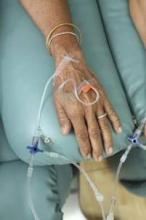Patients with testicular nonseminoma who undergo chemotherapy experience a nearly fivefold increase in the risk of cardiovascular disease mortality in the year following diagnosis, according to findings from a large population-based study.
The standardized mortality ratio (SMR), after accounting for the effects of age, treatment, extent of disease, and other factors on CVD mortality, was 1.36 among 6,909 patients with testicular nonseminoma who underwent chemotherapy and who were included in the Surveillance, Epidemiology, and End Results (SEER) program from 1980 to 2010. Significant excess deaths following chemotherapy occurred only in the first year after testicular cancer (TC) diagnosis (SMR, 5.31; absolute excess risk [AER], 13.90), and included deaths from cerebrovascular disease (SMR, 21.72; AER, 7.43), and heart disease (SMR, 3.45; AER, 6.64), Dr. Chunkit Fung of the University of Rochester (N.Y.) and colleagues, reported online Aug. 3 in the Journal of Clinical Oncology.
No increase was seen in CVD mortality after surgery among 8,097 patients (SMR, 0.81).
Multivariable analyses also showed that the risk of CVD mortality occurred only during the first year after diagnosis (hazard ratio, 4.86), and that distant nonseminoma (HR, 1.91) and older age at diagnosis (HR, 3.47, 8.97, and 34.26 for ages 30-39 years, 40-49 years, and 50 years or older) were independent risk factors, the investigators said (J Clin Onc. 2015 Aug 3. doi: 10.1200/JCO.2014.60.3654.).
The findings “remain to be confirmed in analytic studies that also identify patients with TC at the highest risk of thromboembolic events to formulate comprehensive, evidence-based approaches for risk stratification and reduction,” they concluded, noting that in the interim, effective TC chemotherapy should be administered when clinically indicated, and that clinicians should continue to apply existing clinical practice guidelines for VTE prophylaxis and treatment.
Dr. Fung reported owning GlaxoSmithKline stock; consulting or serving in an advisory role for Janssen Scientific Affairs, Dendreon, and Bayer; and receiving research funding from Astellas Pharma. Coauthor Michael T. Milano received honoraria from Accuray. The remaining authors reported having no disclosures.

